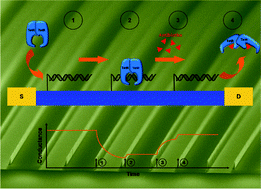Detection of real-time dynamics of drug–target interactions by ultralong nanowalls†
Abstract
Detecting

* Corresponding authors
a
Department of Microsystems Engineering – IMTEK, University of Freiburg, Germany
E-mail:
andreas.menzel@imtek.uni-freiburg.de
b Faculty of Biology, Centre for Biological Signalling Studies (BIOSS) and Spemann Graduate School of Biology and Medicine (SGBM), University of Freiburg, Schänzlestrasse 1, 79104 Freiburg, Germany
c FRIAS, School of Soft Matter Research, University of Freiburg, Albertstraße 19, 79104 Freiburg, Germany
Detecting

 Please wait while we load your content...
Something went wrong. Try again?
Please wait while we load your content...
Something went wrong. Try again?
A. Menzel, R. J. Gübeli, F. Güder, W. Weber and M. Zacharias, Lab Chip, 2013, 13, 4173 DOI: 10.1039/C3LC50694K
To request permission to reproduce material from this article, please go to the Copyright Clearance Center request page.
If you are an author contributing to an RSC publication, you do not need to request permission provided correct acknowledgement is given.
If you are the author of this article, you do not need to request permission to reproduce figures and diagrams provided correct acknowledgement is given. If you want to reproduce the whole article in a third-party publication (excluding your thesis/dissertation for which permission is not required) please go to the Copyright Clearance Center request page.
Read more about how to correctly acknowledge RSC content.
 Fetching data from CrossRef.
Fetching data from CrossRef.
This may take some time to load.
Loading related content
